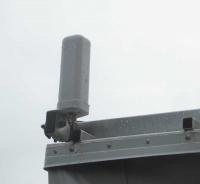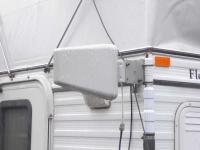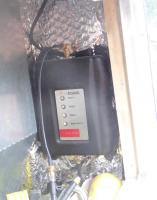Like most of us, we travel to out-of-the way places. Very often, if there is cell service, there is only one provider. In August we are headed for Tuktoyaktuk NT (Arctic Ocean) and then to Saline Valley in October. I will need all three cell companies at various points. I have T-Mobile service, and over the years I have used Verizon and ATT hotspot devices, periodically buying a new prepaid SIM card as needed. I have also purchased SIM cards for other countries. These are not cheap solutions, but they were about the only choice and I could at least deduct them as business expenses. I’m retired now and times have changed. Cell service choices have greatly improved.
Taking advantage of MVNOs (resellers of the main cellphone companies), I’ve put together a package that sets us back an extra $10/mo. (plus about $20 upfront for SIM cards and activation) and gives us at least 200 minutes of voice, 500 text messages and 200 Mb of data on ATT and Verizon and essentially unlimited service on T-Mobile. If you need more Verizon or ATT voice, time or data, you can change plans or add extra time, text or data for $10 to $20 for 30 days.
The monthly cell service cost is $70/mo. (update: this is the age 55+ 2-line plan; it's $70 for 1 line for those younger). The post-paid T-Mobile plan and 2 additional pre-paid SIM cards to access Verizon and ATT costs a total of $80.
If you are interested in voice, text and internet just on your phone, it’s pretty easy – you just have to remember to go to the MVNO’s web site to change plans or add voice/text/data increments as needed.
A Wi-Fi hotspot is possible, but takes more work – ATT and Verizon block the Wi-Fi hotspot function for MVNO providers.
According to www.whistleout.com, LTE coverage for Verizon is about 81% of the US, 66% for ATT and 58% for T-Mobile.Sprint has the least coverage and almost no areas not covered by the other three. T-Mobile over the last year, has deployed hundreds of 600 MHz and 700 MHz antennas in mostly rural areas throughout the US. 600 MHz signals travel a bit farther than 700 MHz, although only new phones support 600 MHz (iPhones don’t). So T-Mobile coverage is moving up closer to Verizon and ATT. For a really good idea of who covers what highways and roads in the US (and elsewhere), go to www.opensignal.com. They report actual signal strength from their app’s users. Whistleout.com (https://www.whistleo...on-coverage-map) has a nice interactive map to compare “official” coverages of the major carriers. Note that with low frequency bands the signal reaches farther - 700 MHz goes about 3 times the distance of 2100 MHz but handle less traffic (lower bandwidth).
Where are the towers? Checkout the Network Cell Info app (by Wilisis) and the Cell Map app (by Ear to Ear Oak). It’s not uncommon to be connected to a more distant tower and thus have a weaker signal. If you find this is the case, you can switch to airplane mode and back or restart your phone to try to connect to the closer tower.
NOTE: All of the main carriers, ATT, T-Mobile, Verizon and Sprint rely on 3rd party providers in some less populated areas. If you are using an MVNO (RedPocket, etc.), you don’t get 3rd party coverage. Verizon covers Alaska reasonably well because it partners with ACS. RedPocket Verizon (CDMA plan) does not include the ACS coverage. But the RedPocket ATT plan covers Alaska quite well because the towers are ATT towers.
IMPORTANT: You need an unlocked phone and one that works on the target carrier’s frequency bands. Recent phones generally do, but do your research. I have read that an iPhone 8 from Sprint or Verizon will work on ATT and T-Mobile (except for LTE band 71), but an iPhone 8 from ATT and T-Mobile won’t work on Verizon. Most newer non-carrier-branded phones (purchased as “unlocked”) usually cover all frequency bands and protocols (GSM, CDMA and LTE). I’m using a Samsung S9+ and a Nexus 5X. Generally, I have the Samsung on T-Mobile and switch the Nexus 5X between ATT and Verizon. The Nexus 5X lacks some of the LTE frequency bands, so occasionally I need to use the Samsung in some areas (and use the Nexus 5X for T-Mobile).
Unlocked ATT and T-Mobile phones (GSM phones) will generally work on both carriers (with a carrier specific SIM card) and usually work with Verizon LTE with a Verizon SIM card. Unless the phone also supports the CDMA protocol, you can’t use Verizon’s 3G and 2G networks. Be sure to check for 3G coverage as well as 4G/LTE for a particular phone. In the future, 3G and 2G service will be phased out and the only issue will be frequency bands. 2G and Verizon’s 1G are likely to be phased out within the next 2 years.
To verify that a phone will work on Verizon 3G, go to https://www.verizonw...e/#/checkDevice. For ATT, go to https://m.att.com/sh.../checkIMEI.html. For T-Mobile, go to https://www.t-mobile...BHUXT2N6JF12578.
Then go to https://www.phonearena.com/news/Cheat-sheet-which-4G-LTE-bands-do-AT-T-Verizon-T-Mobile-and-Sprint-use-in-the-USA_id77933 and compare the carrier’s frequency bands with those that your phone supports.
Our T-Mobile costs us $75 for 2 lines ($55 for one line) with unlimited data (up to 50 Gb at full speed) and no extra charge to run a Wi-Fi Hotspot. Outside of the US, Canada and Mexico, calls are $0.20/min and texting and 2G data are free. If 2G data is not available in a country, you get 3G.
T-Mobile support (technical and customer service) is vastly better than Verizon or ATT. I’ve spent a lot of time on the phone with Verizon where serious tech support in particular is a disaster (I had a MyFi Broadband). It’s a little hard to find plan options on the T-Mobile site, but the phone reps are pretty good at explaining them. Getting through to RedPocket phone support, 888 993 3888 can take 30 minutes sometimes and their web site is a bit difficult to use. FreedomPop (so far) usually answered after a few minutes (888 743 8107) and they have a better web site.
The Package:
NOTE: The following works with Android phones;I have not tried this with iPhones but it should work and the MVNOs claim that it will. Also, plans change - be sure to confirm before jumping in.
Our regular cell service is with T-Mobile which includes free voice, text and data in Canada and Mexico. The other carriers charge significantly extra for this. Because T-Mobile partners with multiple Canadian carriers, it actually has the best Canadian coverage.
To add ATT, sign up with FreedomPop (www.freedompop.com). They have a low usage plan this is FREE (with a caveat) 200 minutes of voice, 500 text messages and 200 Mb of 2G data. Note that the web site makes you confirm that you want to drop down to this plan multiple times, but you can do it. However, when you drop down to the free plan, they charge you $15 which sits as a credit against data/voice/text overages on the free plan. Every time you drop down to the free plan, you get charged whatever it takes to keep the $15 credit. If you have no overages, there is no charge.
Caution: You need to use their FreedomPop Messaging Phone/SIM app and disable it when using the other cell providers.
Pay attention to your monthly billing cycle date. I started on the 10th of the month. When I upgrade, the monthly charge is pro-rated to the next 10th of the month. On the 10th of the next month, if I have not downgraded, I will be charged for the following month. If I downgrade on the 20th, I do not get any credit for the unused portion of the higher level plan. In practice, just downgrade when you are sure you are done with ATT towers.
If you are up for regularly spending an extra $10/mo., go with RedPocket’s GSMA plan. For this you get 500 each of voice, text and data. You can upgrade and downgrade your 30 day plan ($30 for 5 Gb data and unlimited voice & text, for example) or simple add increments of voice, text and/or data ($10 for an additional 1 Gb data). The best option depends on how long you will need ATT towers. See RedPocket Verizon, below, for billing.
To add Verizon, go with Red Pocket’s CDMA plan for $10/mo. for 500 each of voice, text and data. You can upgrade and downgrade your 30 day plan ($30 for 3 Gb data and unlimited voice & text, for example) or simple add increments of voice, text and/or data ($10 for an additional 1 Gb data). The best option depends on how long you will need Verizon towers.
When you need more voice, text or data, just logon or call the provider and bump yourself up to a better plan in $10 increments. Just remember to drop down to the minimum plan for when you don’t need the service. Note that when you change plans, you lose any credit from the current plan, so plan your usage in 30 day increments. Also, watch out for autopay. Autopay works great if you have a base plan and then add voice, text or data increments. You can turn autopay off, but your SIM card & phone number expire in, I believe, 60 days.
For all MVNO providers (RedPocket, FreedomPop), you need to setup their “APN” in order to get on the internet. The MVNOs provide pretty good instructions, and once set up, your phone will switch automatically as you change SIM cards. The APN essentially tells the tower which server to connect to for your internet data.
Be sure to keep paper clips handy to switch SIMs (or use your older (but network compatible phones for each service).
If you have voice but no data, you may need to do a Carrier Reset to get properly re-authenticated with the current tower. First, power off your phone, remove the SIM card. Power on the phone and then power it off. Reinsert the SIM card and power the phone back on. If this doe not work, see the section for your phone(s) from https://support.free...6#-and-##25327# Print it out and take it with you - if you don't have data access, you can't get to this web page.
Minimize Data Usage:
Download google maps offline - this will greatly reduce data needs for maps. https://support.goog...tform=iOS&hl=en
Chrome has an option to compress data with almost no speed hit - sometimes a speed boost as the data is routed through Google's servers. .
Android phones have an option to restrict background data for individual apps and an option to minimize background data. This varies by Android version, so Google "Android restrict Background Data" and "Android Data Saver". iOs appears to have similar features - Google for "iOs" instead of "Android".
Wi-Fi Hotspot for ATT:
While your phone has a Wi-Fi Hotspot feature, ATT and Verizon will block it’s use.
To work around ATT (RedPocket GSMA or FreedomPop), install the PdaNet+ app on your phone and on each device that you want to connect to the internet using your phone. The free version limits connect time but let’s you make sure you can get it up and running. For unlimited access, the Pro version cost me $8 but it may go back to $15. For the Pro version, you need to also download FoxFiKey.
Follow the PdaNet+ instructions (for desktops/laptops, you need to download the desktop PdaNet+). I have not verified that this works on iPhones.
Wi-Fi Hotspot (or maybe Warmspot) for Verizon:
I've had some success getting PdaNet+the hotspot to work. Try exiting and restarting PdaNet+ on your other device and then exiting and restarting PdaNet+ on your phone. If unsuccessful, PdaNet+can also act as a modem for your other devices – you connect a USB cable from your phone to your other device to get it on the internet. Again, follow the instructions from PdaNet+ to get it setup. I have not verifies that this works on iPhones.
Even Better, Wider Coverage:
If your signal is too weak, you can amplify it. This will set you back about $500, but it does work. My rig has a Wilson (WeBoost) omnidirectional antenna and a Wilson 3G/4G amplifier. I also have a Yagi directional antenna, but my newer omnidirectional antenna covers most situations.
GSM (ATT and T-Mobile) 2G and 3G range is generally limited to 35 km (22 miles) due to GSM timing requirements. CDMA (Verizon and Sprint) and LTE signals can travel much further, potentially up to 100 km (66 miles) for LTE. Cell providers, however, often impose stricter limits. In addition, as the traffic on a specific tower increases, the tower may refuse calls beyond an ever shrinking distance.
But distance is not the only problem – hills, buildings and other objects can significantly diminish the signal. Note also that a weak signal provides much less bandwidth, which becomes very obvious with internet traffic.
As noted above, we travel a lot in out of the way places, and we use the amplifier about 1/3rd of the time. In Saline Valley, the amplifier and ATT are the only solution.
The amplifier comes with an “inside” antenna. Although Wilson implies that your phone only needs to be within 36”, by far the best method is to slap the inside antenna right up next to the phone. Signal strength decreases by the square of the distance – the closer the better.
Having recently upgraded to a better unidirectional antenna, we don’t use the directional Yagi very often. But when we need to, the above noted cell tower location apps make it easy to point the Yagi to the tower.
The amplifier is a Wilson (WeBoost) Drive 4G-X. Current model is 470510 and the omnidirectional antenna is a Wilson 4G Omni Building Antenna 304424. The Drive 4G-M amplifier is similar, but has a weaker upload signal gain. There are cheaper omnidirectional antennas, but they usually don’t cover all of the bands that you need. The Yagi is a Wilson Wideband Directional Antenna 50 ohm 314411.
There are other amplifier vendors, but Wilson (WeBoost) still appears to be the clear winner and sales and technical support is first class
Edited by Jack, 18 July 2018 - 08:11 PM.






















